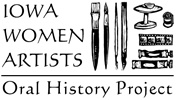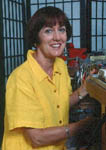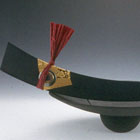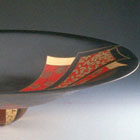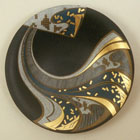BALPREET KAUR
(formerly Barbara Nilausen-K)
artwork | audio | statement | 2008 update
artwork
audio 
(see also Art & Spirituality)
- Early interests (57 sec. | 391KB): listen | read
- Undergraduate (51 sec. | 348KB): listen | read
- Theater to art (44 sec. | 299KB): listen | read
- Univ. of Iowa (60 sec. | 408KB): listen | read
- Artwork (59 sec. | 406KB): listen | read
- Transcendence (48 sec. | 330KB): listen | read
artist statement
My undergraduate degree in theater and a masters in ceramics have provided me with a strong vocabulary of forms and ideas to interpret in metalsmithing. Inspiration for the latest series of work is drawn from Japanese woodblock prints as well as the colorful and elaborate kimonos worn in Kabuki performances.
I prefer black surfaces and have abandoned working with patinas in favor of an archival process which consists of using auto lacquer to build up a grainy surface; with cast iron appearance. Gold foil and prisma color are applied as accents. The resulting work is new and dramatic.
I once believed that I chose Art, but I now know Art chose me. Drawing and then painting at an early age, years of classical ballet, voice and music lessons, theater—the Arts have always been with me and I with them. Indeed, my greatest gift has been a life in Art.
2008 update
After the interview, my parents became very ill. I stopped practicing my art form in Spring of 2000 and took care of both parents as they went through congestive heart failure and pancreatic cancer. My mother, who always saw to it that I had every art lesson that she could afford, died in March of 2001. My father, who was the eye surgeon and inspiration for my initially trying medicine, died in April of 2001. Funerals for both parents were planned by me. The next few months were spent clearing out my parents' home, dividing the family estate, and selling or giving away to charity items that no one wanted.
I tried to return to art in August of 2001 but would just sit at the bench and stare. My close friend, who I now live with in the Quad Cities, suggested that he would train me as a Lasik surgical tech. I took the opportunity and am now running the Lasik OR at the Virdi Eye Clinic.
I have looked at my work online and have all my equipment in the basement of our home, but have not been motivated to do any work as yet. I was given a gift, I do recognize that. However, the caring and death process took such a toll that I do not know when I will return to art. I have taken tai chi, chi gong, and am working toward a Reiki Mastership in the Reiki Jin Ki Do/Reiki Shindo lineage. My hope is to work with death and dying. Of late I have begun to sit at the bench again and am contemplating designing a ring for myself. The sculptural small table forms are beginning to pop back into my head.
Finally, I have had a name change. I am now legally Barbara Balpreet Kaur. I do not use my first name but go by Balpreet Kaur. I have re-entered Sihkism which I had converted to in 1981. My father, who was a very devote Catholic, finally on his deathbed gave his blessing. My son also recognized that it was important to me, too. So I had two blessings. My son will soon have his Ph.D. in Chemical Engineering from the U. of Iowa.
audio text
Early interests
tMy mom made sure that I was enrolled in some summer classes in art. And then my mom made sure that I had ballet lessons; I had eight years of classical ballet. I had voice lessons. I studied clarinet.ext
My activities in high school were primarily theater. I was in several of the musicals and a couple of the plays. At that point in time I wanted to be either a heart or a brain surgeon. There was one art class that I took my senior year, mainly because I had taken everything else in the science classes, and I couldn't figure out what else to take, so I took an art class. Doesn't that sound terrible?
A friend of my dad's, Web Gelman, who has retired from medicine and who is a practicing artist, and prefers to be called an artist—I remember at one point in time my parents talking to him, because they felt that I belonged in the arts, but I was rejecting it totally. And Web said, "Just let her go her own way. If she's supposed to come to art, she will."
Undergraduate
My freshman and then part of my sophomore year were in pre-med. And someone dared me to try out for a play, and I tried out just for the heck of it and got a part. One of the women that I met in the theater department happened to be African-American. And so Ruth and I became very close. And at that point in time, then, I had switched; I was in the theater department.
I think through knowing Ruth, and also everything was in the newspaper, I began to see what was going on within the African-American community, and was very troubled by this. And then I became active within the Black Student Union. I was in some marches in Dubuque. I dated a young man who was African-American my senior year in college. We've remained friends over the years. And he's been a great support, actually, in the raising of my son, who happens to be African-American.
Theater to art
I'd been in a U.S.O. tour overseas. We toured what they called the hardship command; that's where I met my former husband. And then came back to Clarke College. I enjoyed the tour, but there was a lot of pettiness that I saw. I was very good friends with another drama major, and we had tried out for the same play, and I got the part, and she wouldn't have anything to do with me. I realized this was just a very small view of what the theater world would be like. Because of the pettiness, I started taking art history and then a couple drawing classes, a couple sculpture classes, and then I took a ceramics class, and I ended up with a minor in art.
Univ. of Iowa
My coming back to the University of Iowa was a real experience. I'd be working late in the ceramics studio. My professor at that time was a very interesting man. He didn't like the idea that I'd been accepted by the art faculty. He took one look at me and he said, "You're too tiny, you're too pretty, and you need to go home and make babies." I wanted to kill him. So with that, I learned to carry a hundred pounds of clay—because you had to be one of the boys, you know. In Denmark, nobody would come up to you and try to fondle you. And this guy, you couldn't bend over—I mean, it was just a mess! I was so angry to be treated like this as a woman.
Somebody told me about this feisty Korean. So I took a couple classes from Miss Choo, and I thought, Yeah, okay, this is doable. I like this; I like pounding metal. So I started taking metalsmithing, and then that became my minor. And then I switched for my master of fine arts to metalsmithing.
Artwork
In graduate school, I was very much interested in biomorphic shapes. A lot of my forms were very fatful, bulbous forms. I was very interested in plant forms. I spent a lot of time out in the fields around the farmhouse photographing plant forms, and that influenced my work. So some of the earlier work—the ceramic work—I would have a form and it would be repeated.
As I worked with Miss Choo, I combined metals and ceramics for a while. I think the ceramics influenced the metalsmithing, and the metalsmithing influenced the ceramics, and [I] started creating forms that were very sleek and clean. I was influenced, probably, by my stay in Denmark; the work is very clean.
The pieces are copper, with prismacolor, 24K gold foil, and then a combination of sometimes paper, sometimes jewels. And then it's fixed with what's called UV krylon.
Transcendence
I was asked to make a cup that dealt with a political, social, or economic issue. And I chose the rape of women in Bosnia. So the imagery there is a rose and rose petals and thorns. And one set of thorns—the thorns are actually the penis and the act of rape, and they're pushing up through the petals. So the lower petals are darkened a grayed silver, and then as you get closer to that inner core of the rose, the petals become the true color of silver. And then the inside of the rose is gold, 24K gold, and that represents the soul—at least that was the idea. And hopefully that the soul remains undisturbed. And it was called Dua, A Prayer for Transcendence.
